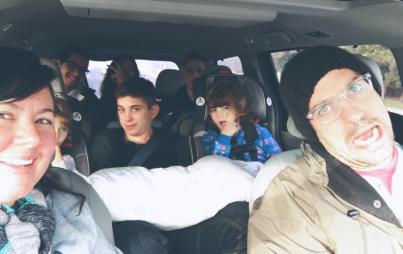
I am an adult woman, and guess how many dollhouses I own? Two.
It’s OK if you can barely turn around in your kitchen. You can still cook. And you can still have really, really nice countertops.
It was a few years ago, before tiny houses were featured on TV shows or anything like that. I was talking to my older sister on the phone and she said something about “tiny houses” in passing. I had never heard that phrase before, so she explained.
“They’re like, tiny, under 500 square feet.”
“I can’t think in square feet,” I said. “I don’t even know how many square feet my apartment is.”
“Just Google it. When we get off the phone. I’m surprised you’re not already obsessed with them! You’ll seriously love it.”
She was right. I fell into a tiny house love. I spent hours just on the Tumbleweed site alone. They were so, well, tiny! They were so cute! They were so efficient! With no money to speak of, I picked the tiny house layout that was best for me. I decided what colors I would paint it. I weighed the options of stationary tiny house versus mobile tiny house (I’m a stationary all the way kind of girl, myself, but you do you). I was totally obsessed.
♦♦♦
Let me tell you a thing about me. I am an adult woman, and guess how many dollhouses I own? Two. I have plans to build a third once I’m done rehabbing the second one for my son. I’m not even kidding — that is a serious sentence. I’m going to rehab my childhood dollhouse for my kid.
I don’t like the carpet in it, so I’m going to pull it out and install tiny hardwoods. I’m going to repaint the exterior. It’s a two-bedroom Victorian with an attic. It’s going to be nice. And then, when I’m done with that, I’m going to build a third dollhouse for myself. Because I want to.
Because I just like tiny shit, OK?
I can trace it back, my love of tiny things. That first dollhouse — not my childhood dollhouse, the other one used to belong to my great-grandmother. It’s an antique. It’s robin’s-egg blue with white shutters on all the windows. The front of the house is two big doors that swing open so you can play.
They don’t make them like that anymore. They don’t make them like they used to. When I was a child, it was my favorite thing in the world. It has a tiny copy of The New Yorker. It has a tiny cast iron skillet that is actual cast iron. It has tiny four-poster beds. None of the other kids were allowed to play with that dollhouse without supervision.
But my great-grandmother, she knew I would take good care of it. When she finally went into a nursing home, near the end of her life, it came to me. Of all of my material possessions on this earth, I love that one the most.
♦♦♦
For years, I dreamed about simplicity. A cabin in the woods. Some place small. I would wistfully remark how many cooking pots I thought the ideal kitchen should have (it’s two, maybe three — maybe). Then, finally, when I was 23, I ditched living with roommates and moved into a studio apartment.
The main appeal was that the space would be all mine and I wouldn’t have to share. I figured I wouldn’t mind having a living room that was also my bedroom if I never had to come home to someone else’s drunk friends there. After I signed the lease, I began to see smallness not as something to be worked around, but as a selling point.
This studio apartment had the smallest kitchen I had ever seen. You could tell it used to be a closet. I could stand in the middle of it.
To the left, there was a very small oven and stove. To the right, there was a small-ish refrigerator. Directly in front of me was an ancient enamel sink with two mismatched faucets. Above the stove was a window, and near the refrigerator there was a cabinet that went all the way up to the high ceiling. That’s it. Behind me was the doorway. There wasn’t room for two people to stand in it. It was so small as to seem completely nonfunctional to almost everyone...everyone but me.
I put a rolling countertop right outside the kitchen doorway so I would have a place to chop veggies and knead dough. I got rid of all but two cooking pots. I got rid of my toaster. I got rid of my microwave. That apartment was my cabin in the woods, only it was in the city. I loved it. I loved it deeply and completely. I cannot convey my affection fully.
But eventually I had filled the apartment with giant paintings, and I had two cats, and I was almost 25, and I had to admit that I had outgrown the space.
Americans tend to occupy more space than we need. We tend to use more resources than we need. I think part of it is capitalistic ideology that is so deeply imbedded that we sometimes don’t even see it. A lot of people don’t just want the biggest house they can afford, they want a house just bigger than they can afford.
When we have more space, we tend to spread out, then we can’t imagine what it would be like to live with less. Where would we put all of our things?
The tiny house movement is, in large part, a response to that. It is also specifically a middle-class response to that. The tiny-house people are telling us that we can have a really well-designed, really beautiful, space, and it can be smaller. Not just smaller, it can be tiny.
This is a movement about taking that idea — Americans take up too much damn space — and swinging hard in the other direction. It’s OK if you can barely turn around in your kitchen. You can still cook. And you can still have really, really nice countertops.
But I am not middle class.
Tiny houses are touted as an affordable solution but they’re still more house than I can afford. So while tiny-house enthusiasts boasted that you could own your own home — mortgage-free! — for only $20,000, that price tag knocked the wind out of me. Building a tiny house, like so many other things, became the dream that I would accomplish in the mythical future. The future when I would have money.
The future when I would stop working retail jobs and do…what, exactly?
♦♦♦
Last year, my wife and I were living in a big, beautiful old house. We had to live with roommates to afford it. Our cats loved it — one cat basically had her own room. But I was sick a lot — first because I was pregnant, and then I was sick because I had recently given birth. I couldn’t get around very well, and getting up and down the stairs was hard. We had all of this space.
We had an office and an art studio we barely went in. The baby had a nursery he never once slept in. I lived almost my entire life in one room.
Then it was time to move.
Due to speculation and gentrification, prices in our city, though still considered cheap by many people’s standards, have gone up considerably in a very short amount of time. Whereas once we could have afforded a very nice place, we were now just hoping for a place with enough room for most of our things. After a stint living in our local anarchist collective, we finally got someone to let us sign a lease for a tiny two bedroom apartment.
But where will we put all of our things?
My wife and I joke about it.
“It’s just like a tiny house, but it’s an apartment! It’s a tiny house for poor people!”
We each got rid of about half of our wardrobes. We scaled back on all kinds of things. The kitchen is very small, but after getting married and having a child, I now own more than two cooking pots. We have at least five cooking pots and two cast iron skillets.
They are the grown-up version of the tiny skillet in the dollhouse. We had to find space for them.
The irony is, the dollhouses are in storage.
The tiny house movement has gained more and more steam. Now there are reality shows. There are blogs. There is the shock factor, yes, but there are also many people still extolling the virtues of tiny living. Americans, they just take up way too much space.
But I haven’t found anyone talking about the virtues of living in a tiny apartment, and no one wants to watch that show.







